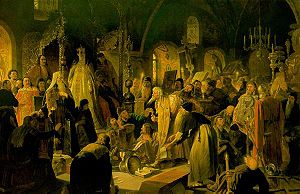
Patriarch Joachim
Encyclopedia

Raskol
Raskol |schism]]') was the event of splitting of the Russian Orthodox Church into an official church and the Old Believers movement in mid-17th century, triggered by the reforms of Patriarch Nikon in 1653, aiming to establish uniformity between the Greek and Russian church practices.-The Raskol:...
(the Old Believer schism
Schism (religion)
A schism , from Greek σχίσμα, skhísma , is a division between people, usually belonging to an organization or movement religious denomination. The word is most frequently applied to a break of communion between two sections of Christianity that were previously a single body, or to a division within...
), and a founder of the Slavic Greek Latin Academy
Slavic Greek Latin Academy
Slavic Greek Latin Academy was the first higher education establishment in Moscow, Russia.-Beginnings:...
.
Born Ivan Petrovich Savelov (Иван Петрович Савелов), Joachim was of noble origin. When his family died in the 1654 epidemic, he became a monk
Monk
A monk is a person who practices religious asceticism, living either alone or with any number of monks, while always maintaining some degree of physical separation from those not sharing the same purpose...
and served in various monasteries, receiving the religious name
Religious Name
A religious name is a type of given name bestowed for a religious purpose, and which is generally used in religious contexts. Different types of religious names may be in use among the clergy of a religion, as well in some cases among the laity....
Joachim upon his tonsure
Tonsure
Tonsure is the traditional practice of Christian churches of cutting or shaving the hair from the scalp of clerics, monastics, and, in the Eastern Orthodox Church, all baptized members...
.
In 1664 Joachim was elevated to the rank of archimandrite
Archimandrite
The title Archimandrite , primarily used in the Eastern Orthodox and the Eastern Catholic churches, originally referred to a superior abbot whom a bishop appointed to supervise...
and became hegumen
Hegumen
Hegumen, hegumenos, igumen, or ihumen is the title for the head of a monastery of the Eastern Orthodox Church or Eastern Catholic Churches, similar to the one of abbot. The head of a convent of nuns is called hegumenia or ihumenia . The term means "the one who is in charge", "the leader" in...
(abbot) of the Chudov Monastery
Chudov Monastery
The Chudov Monastery was founded in the Moscow Kremlin in 1358 by Metropolitan Alexius of Moscow. The monastery was dedicated to the miracle of the Archangel Michael at Chonae...
and in 1672 was consecrated as Metropolitan
Metropolitan bishop
In Christian churches with episcopal polity, the rank of metropolitan bishop, or simply metropolitan, pertains to the diocesan bishop or archbishop of a metropolis; that is, the chief city of a historical Roman province, ecclesiastical province, or regional capital.Before the establishment of...
of Novgorod
Archbishop of Novgorod
The Archbishop of Novgorod is the head of the eparchy of Novgorod the Great and is one of the oldest offices in the Russian Orthodox Church. The archbishops have, in fact, been among the most important figures in medieval Russian history and culture and their successors continued to play...
. He was elected a Patriarch on July 26, 1674, following the death of Patriarch Pitirim
Pitirim of Krutitsy
Pitirim of Krutitsy was the ninth Patriarch of Moscow and All Russia.When Nikon held the post of patriarch, Pitirim was a metropolitan of Krutitsy. When Nikon willfully left the altar, Pitirim became his deputy and acted on his own as a real patriarch without even dealing with Nikon...
. Although Joachim had participated in the council which deposed
Deposition (politics)
Deposition by political means concerns the removal of a politician or monarch. It may be done by coup, impeachment, invasion or forced abdication...
Patriarch Nikon
Patriarch Nikon
Nikon , born Nikita Minin , was the seventh patriarch of the Russian Orthodox Church...
, he continued Nikon's policies with regard to the Old Believers
Old Believers
In the context of Russian Orthodox church history, the Old Believers separated after 1666 from the official Russian Orthodox Church as a protest against church reforms introduced by Patriarch Nikon between 1652–66...
, and defending church authorities against the encroachments of Caesaropapism
Caesaropapism
Caesaropapism is the idea of combining the power of secular government with, or making it superior to, the spiritual authority of the Church; especially concerning the connection of the Church with government. The term caesaropapism was coined by Max Weber, who defined it as follows: “a secular,...
by the Tsar
Tsar
Tsar is a title used to designate certain European Slavic monarchs or supreme rulers. As a system of government in the Tsardom of Russia and Russian Empire, it is known as Tsarist autocracy, or Tsarism...
s.

